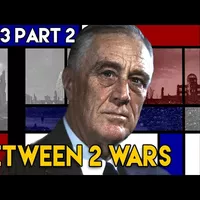The State of the US is Depressing - The Great Depression | BETWEEN 2 WARS I 1933 Part 2 of 3 - YouTube (2)
His first priority is fixing the banking system.
He declares a mandatory bank holiday and then pushes the Emergency Bank Act into legislation.
The act gives the government the power to close banks in danger of failing and reopening
those that will be stable.
The Fed is empowered to pump more currency into banks.
These immediate measures do much to re-foster public trust in the banking system so that
depositors quickly stop hoarding their cash and place it back into savings.
The regular operation of banks begins again, and the stock markets react positively.
Although it's difficult to discern any single economic theory behind his policy, Roosevelt
is certainly convinced that it is essential to 'reflate' the economy, meaning that the
severely depressed prices have to rise.
For that, cash needs to move more freely though, and with this in mind, he prohibits the private
hoarding of gold currency and bullion, the export of gold, and takes government control
over domestic gold production already in early April 1933.
Two weeks later, on the 20th, he unlinks the dollar from the gold standard to let it be
traded at free market valuation.
The dollar plunges by 11.5% against the European currencies still held to the gold standard.
This gives hope for increased exports, and the stock market rises, enabling the acquisition
of much-needed capital for the ailing industry.
Social programs designed to stimulate the economy are also introduced.
The most famous is the Civilian Conservation Corps (CCC).
If they were single, healthy, unemployed, and a member of a family on relief, young
men could sign up to the Corps and go to help preserve and repair America's agricultural
economy.
Most of their wages will go to the man's family as he works to build bridges, prevent floods,
save crops from grasshoppers, and other such tasks.
Huge stimulus packages are introduced.
The Public Works Administration (PWA) is set up and empowered with $3.3 billion, which
is around 5.9% of the nations entire economy, to fund large-scale public works such as dams,
bridges, and schools.
Other agencies are formed such as the Civil Works Administration, a jobs creation program
which by the end of the year 1933 has already provided 4 million Americans with work.
All of this is supported by a Presidential public communications program, the first of
its kind, with biweekly press conferences where FDR continues to exude confidence.
He frequently broadcasts his "fireside chats" on the radio where he casually relays his
policy to
the public.
But to turn around this huge drifting ship that is the United States of America, and
have her sailing at full speed again is no small task, and it meets its challenges.
Some of the programs that the FDR White House introduces are seen as government overreach,
one of them- the National Industrial Recovery Act- is even found unconstitutional by the
Supreme Court and overturned.
At any rate, this unprecedented federal involvement in the economy changes US politics forever.
Also, In parallel to the economic downturn, massive droughts strike the midwest in three
waves to create the infamous and iconic Dust Bowl.
This part natural, part manmade disaster creates terrible hardship across rural America.
Nonetheless, the economy grows by over 10% most years for the rest of the 1930s, though
in 1937/38 it briefly slips back into recession as FDR's administration ends many of the New
Deal programs.
Taxes are raised so that the top tax bracket is at 79% by 1936, raising accusations of
damaging the free market economy through wealth redistribution.
Public debt soars from $23 billion in 1933 to $40 billion by 1939, leaving future administrations
to deal with some of the effects.
When the last drought ends, and the dust settles in 1939, unemployment has sunk to 17%, but
that's far from full employment and GDP is still not back to the 1929 level.
The Great Depression, though, keeps the US mostly involved with itself instead of taking
an active part in the dramatic events of the world in the 1930s.
The crisis sends repercussions across the globe, contributing to the destabilization
of the world economy during the entire decade.
In an ironic twist of history, it is the ensuing global conflagration that which will finally
bring America back from the precipice of bankruptcy once and for all.
If you'd like to see how the crisis begins, then watch our video on the Wall Street Crash
which you can click on right here... any moment now…
Our TimeGhost Army member of the week is Kristian Petrov.
With contributions from people like Kristian, we can avoid Depression and continue doing
more content like this.
Be like Kristian and join the TimeGhost Army on Patreon or timeghost.tv.
Subscribe and ring the bell.
And remember the wise words of Pythagoras: “Concern should drive us into action, not
into a depression.
No man is free who cannot control himself.”
Cheers!

